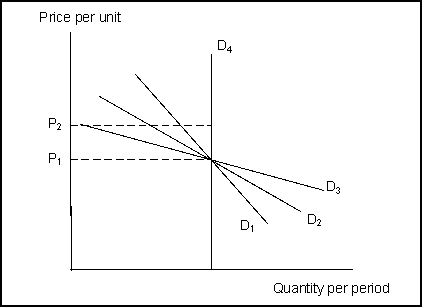A) normal.
B) a luxury.
C) inferior.
D) a staple or necessity.
Correct Answer

verified
Correct Answer
verified
Multiple Choice
The price elasticity of demand is measured by:
A) dividing the percentage change in price by the percentage change in quantity demanded.
B) dividing the percentage change in quantity demanded by the percentage change in price.
C) subtracting the percentage change in price from the percentage in quantity demanded.
D) adding the percentage change in price to the percentage change in quantity demanded.
Correct Answer

verified
Correct Answer
verified
Multiple Choice
The demand for agricultural output is price inelastic. This means that if farmers, taken collectively, have a bumper crop, they will experience:
A) lower prices, greater quantities sold, and lower incomes.
B) higher prices, greater quantities sold, and higher incomes.
C) lower prices, quantities sold, and incomes.
D) higher prices, quantities sold, and incomes.
Correct Answer

verified
Correct Answer
verified
Multiple Choice
Demand is price inelastic if:
A) the price of the good responds slightly to a quantity change.
B) the demand curve shifts very little when a demand shifter changes.
C) the percentage change in quantity demanded is relatively small in response to a relatively large percentage change in price.
D) all of the above are true.
Correct Answer

verified
Correct Answer
verified
Multiple Choice
The price elasticity of demand can be found by:
A) examining only the slope of the demand curve.
B) measuring absolute changes in price and quantity demanded.
C) examining the relative percentage change in quantity demanded to the relative percentage change in price.
D) knowing that when price changes, the quantity demanded goes in the opposite direction.
Correct Answer

verified
Correct Answer
verified
Multiple Choice
If the demand for a good is price elastic in comparison to one that is price inelastic, then :
A) a higher per-unit sales tax will generate more tax revenue.
B) a higher per-unit sales tax will generate less tax revenue.
C) changes in total per-unit sales tax revenue brought about by a price change go in the same direction as the price change.
D) none of the above is true.
Correct Answer

verified
Correct Answer
verified
Multiple Choice

 -(Exhibit: Demand and Price Elasticity 1) What is the price elasticity of demand between $2.50 and $2.25?
-(Exhibit: Demand and Price Elasticity 1) What is the price elasticity of demand between $2.50 and $2.25?
A) -9
B) -19
C) indeterminate
D) none of the above
Correct Answer

verified
Correct Answer
verified
Multiple Choice
If a 5 percent reduction in the price of a commodity results in a 3 percent increase in the quantity demanded, demand is said to be:
A) unstable.
B) price inelastic.
C) price elastic.
D) unit price elastic.
Correct Answer

verified
Correct Answer
verified
Multiple Choice
The income elasticity of demand for peaches has been estimated to be 1.43. If income grows by 15 percent in a period, how will that affect demand for peaches in that period, all other things unchanged?
A) demand will increase by less than 15 percent
B) demand will increase by 21.5 percent
C) demand will decrease by 21.5 percent
D) demand will decrease by 15 percent
Correct Answer

verified
Correct Answer
verified
Multiple Choice
If the price of chocolate-covered peanuts increases and the demand for strawberry-flavored soft drinks decreases, this indicates that these two goods are:
A) unrelated goods.
B) complementary goods.
C) inferior goods.
D) substitute goods.
Correct Answer

verified
Correct Answer
verified
Multiple Choice
Suppose that the cross price elasticity of demand for Mountain Dew with respect to the price of Coke is 0.7. A 10 percent increase in the price of Coke would:
A) reduce the demand for Mountain Dew by 10 percent.
B) reduce the demand for Mountain Dew by 7 percent.
C) increase the demand for Mountain Dew by 7 percent.
D) increase the demand for Mountain Dew by 10 percent.
Correct Answer

verified
Correct Answer
verified
True/False
If changes in price and total revenue move in the same direction, demand is price elastic in that portion of the demand curve.
Correct Answer

verified
Correct Answer
verified
True/False
If a demand curve has a constant slope, price elasticity will also be constant.
Correct Answer

verified
Correct Answer
verified
Multiple Choice
The income elasticity of demand for ground beef has been estimated to be -0.197. If income drops by 10 percent in a period, how will that affect demand for ground beef in that period, all other things unchanged?
A) demand will increase by less than 1.97 percent
B) demand will increase by 1.97 percent
C) demand will decrease
D) demand won't change, but quantity demanded will decrease by 1.97 percent
Correct Answer

verified
Correct Answer
verified
Multiple Choice
If demand is price elastic, it is certain that:
A) any change in price will decrease total revenue.
B) a decrease in price will lower total revenue.
C) an increase in price will lower total revenue.
D) total revenue is at a maximum.
Correct Answer

verified
Correct Answer
verified
Multiple Choice
The price elasticity of a good will tend to be greater:
A) the longer the relevant time period.
B) the fewer number of substitute goods available.
C) if it is a staple or necessity with few substitutes.
D) All of the above are true.
Correct Answer

verified
Correct Answer
verified
Multiple Choice
 -(Exhibit: Estimating Price Elasticity) Between the two prices, P1 and P2, which demand curve has the highest price elasticity (absolute value) ?
-(Exhibit: Estimating Price Elasticity) Between the two prices, P1 and P2, which demand curve has the highest price elasticity (absolute value) ?
A) D1
B) D2
C) D3
D) D4
Correct Answer

verified
Correct Answer
verified
Multiple Choice
For a normal good, income elasticity of demand will be:
A) negative.
B) positive.
C) zero.
D) determined by the direction of the change in income.
Correct Answer

verified
Correct Answer
verified
True/False
If price increases, quantity demanded decreases and, therefore, total revenue must fall.
Correct Answer

verified
Correct Answer
verified
True/False
If the percentage change in quantity is less than the percentage change in price, demand is said to be price inelastic.
Correct Answer

verified
Correct Answer
verified
Showing 161 - 180 of 256
Related Exams